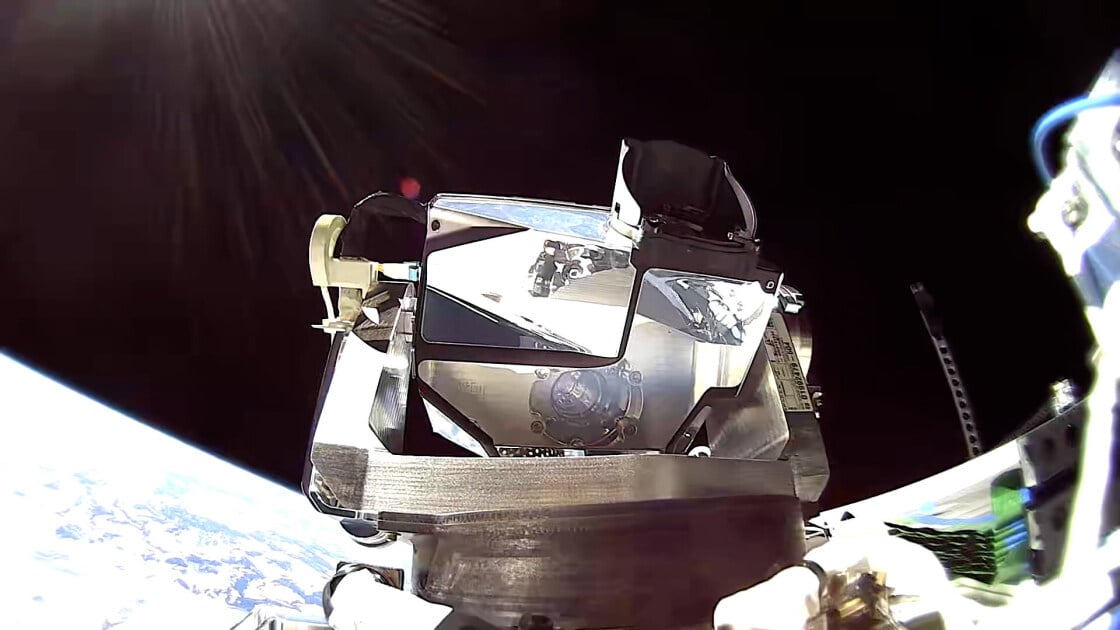Don’t miss out on our latest stories. Add PCMag as a preferred source on Google.
Starlink’s laser technology is expanding beyond SpaceX. On Tuesday, the startup Muon Space announced that it’s integrating the technology into its own satellites to provide them with an optical fiber-like connection to the orbiting Starlink constellation.
The startup will tap SpaceX’s “mini laser terminals,” which can support a 25Gbps connection between two satellites at a range of up to 4,000 kilometers. Muon Space plans on launching the “first Starlink-enabled Halo satellite in Q1 2027,” and has already started integrating the mini laser equipment in current customer satellite systems.
(Credit: SpaceX)
SpaceX originally developed the laser system so that Starlink satellites can essentially act as a mesh network in space, giving them a way to fetch data from each other and further reduce latency. However, early last year, the company also mentioned porting the laser system to third-party satellites, representing a new way for SpaceX to commercialize Starlink technology.
For Muon Space, the deal is important since the startup supplies weather and climate-monitoring satellite systems to third-party clients, including the US Space Force. “With persistent optical broadband, Muon Halo satellites will move from being isolated vehicles to becoming active, real‑time nodes on Starlink’s global network,” CTO Pascal Stang says.
Recommended by Our Editors
The results should eliminate communication delays with the satellites, making them as responsive as “cloud providers and telecom networks on the ground,” the startup adds.
Last year, a separate US aerospace company, Vast, also announced plans to use the laser system on its “Haven-1” private space station, which is slated to launch sometime in 2026. SpaceX’s current laser system for Starlink can operate at up to 200Gbps. However, earlier this year, the company announced the development of a smaller, mini laser system for third-party customers, which can support up to a 25Gbps connection.
Get Our Best Stories!
Your Daily Dose of Our Top Tech News

Sign up for our What’s New Now newsletter to receive the latest news, best new products, and expert advice from the editors of PCMag.
Sign up for our What’s New Now newsletter to receive the latest news, best new products, and expert advice from the editors of PCMag.
By clicking Sign Me Up, you confirm you are 16+ and agree to our Terms of Use and Privacy Policy.
Thanks for signing up!
Your subscription has been confirmed. Keep an eye on your inbox!
About Our Expert

Michael Kan
Senior Reporter
Experience
I’ve been a journalist for over 15 years. I got my start as a schools and cities reporter in Kansas City and joined PCMag in 2017, where I cover satellite internet services, cybersecurity, PC hardware, and more. I’m currently based in San Francisco, but previously spent over five years in China, covering the country’s technology sector.
Since 2020, I’ve covered the launch and explosive growth of SpaceX’s Starlink satellite internet service, writing 600+ stories on availability and feature launches, but also the regulatory battles over the expansion of satellite constellations, fights with rival providers like AST SpaceMobile and Amazon, and the effort to expand into satellite-based mobile service. I’ve combed through FCC filings for the latest news and driven to remote corners of California to test Starlink’s cellular service.
I also cover cyber threats, from ransomware gangs to the emergence of AI-based malware. Earlier this year, the FTC forced Avast to pay consumers $16.5 million for secretly harvesting and selling their personal information to third-party clients, as revealed in my joint investigation with Motherboard.
I also cover the PC graphics card market. Pandemic-era shortages led me to camp out in front of a Best Buy to get an RTX 3000. I’m now following how President Trump’s tariffs will affect the industry. I’m always eager to learn more, so please jump in the comments with feedback and send me tips.



